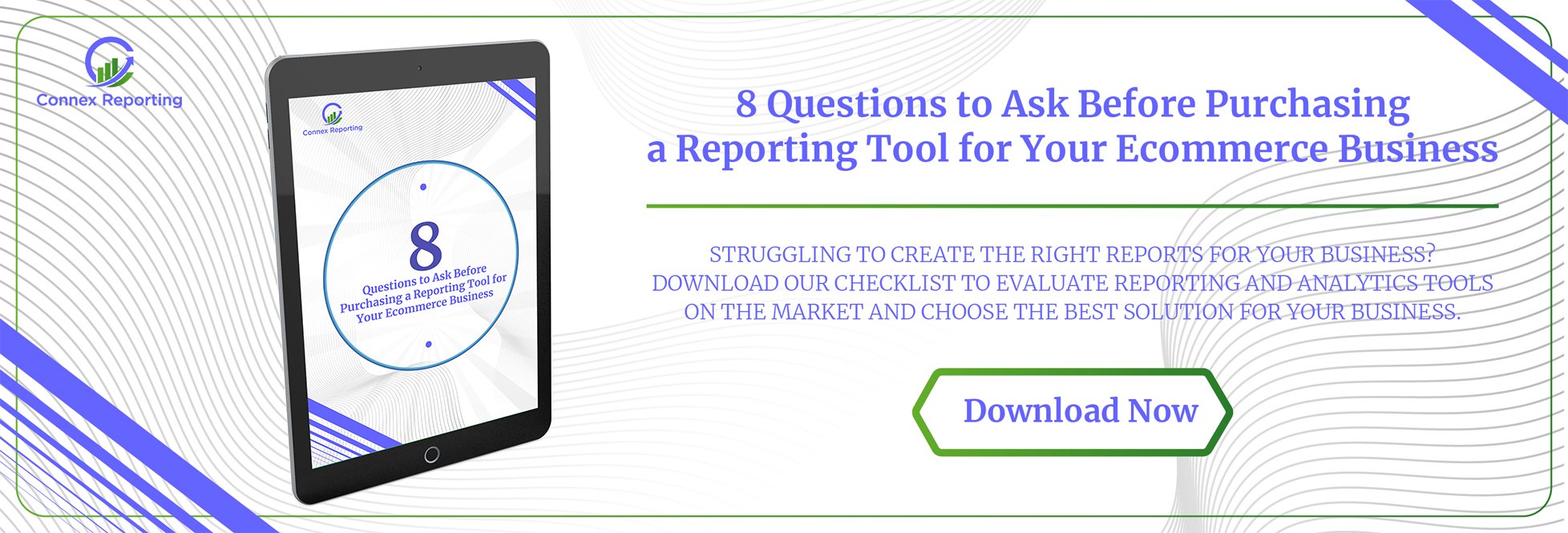The Most Important Metrics for Ecommerce?
As a business owner, it can be difficult to stay profitable without the right tools and strategies. That's why it's important to monitor key metrics that give you insight into your store's performance and where you can improve.
This article covers 10 key metrics every eCommerce seller needs to keep an eye on to stay profitable. We'll also discuss how our reporting tool can provide helpful insights into sales, price increases, and more, so you can make an informed decision and improve your bottom line.
By understanding and tracking these metrics, you'll be able to quickly identify and address any issues that could negatively impact your business. Keep reading to learn more!
What are eCommerce metrics and KPIs?
E-commerce metrics and KPIs (Key Performance Indicators) allow businesses to understand how well their online stores perform. These metrics can provide insight into the health of an eCommerce business and inform decisions about how to grow and optimize operations.
Key Performance Indicators (KPIs) provide a snapshot of your store's performance, allowing you to track changes over time and measure progress. The key is to focus on the right KPIs and metrics, which will depend on your business type, the size of your organization, and what you are trying to achieve.
1) Sales Volume
Sales volume refers to your business's total sales in a given period. According to a report from Zendesk, the most important metric for eCommerce businesses is sales volume.
Sales volume indicates the number of products you're selling and how successful your efforts are. It's a key metric for measuring revenue growth, and it's essential to track sales volume so you can determine the efficacy of your marketing and advertising strategies.
That's why tracking the total number of items sold per day, week, month and year is essential for any eCommerce seller. You need to know how many items you're selling on each channel, what categories and products are selling the most, and where there may be an opportunity for improvement.
2) Average Order Value
Average order value (AOV) measures how much customers spend per purchase. A blog published by Bigcommerce shows that the average order value (AOV) is one of the most important metrics for any e-commerce seller. The AOV is the average amount of money spent in a single transaction on your website.
A high AOV usually indicates an engaged customer base and high-quality products. To increase your AOV, you can offer discounts or bundle deals, encourage shoppers to buy more expensive items, or upsell and cross-sell related products.
To get an accurate understanding of the AOV, it's important to track it over time and compare it against other channels and campaigns. Additionally, AOV should be tracked separately for new customers and existing customers, as this will give insight into their purchasing behavior. Finally, you can track this metric closely to ensure you get the most out of each customer purchase.
3) Gross Margin
Gross margin measures the profit your business makes after subtracting production and other costs from total revenue. Research by Mckinsey shows that gross margin is a key metric for predicting future success in e-commerce businesses.
Gross margin measures the difference between the cost of goods sold and the sale price, expressed as a percentage of sales. For example, if your cost of goods sold was $100 and you sold your product for $120, your gross margin would be 16.7%.
It's important to look at this metric as a one-time figure and over time. If you are seeing a decrease in gross margin over time, it could indicate an issue with cost structure or pricing. This metric can also be used as a guide when creating strategies such as discounts, bundling products together, or raising prices.
We recommend looking at your gross margin for each product separately, as well as across all products, so that you can identify any trends. Monitoring this metric will allow you to make informed decisions about your business and help you stay profitable.
4) Customer Acquisition Costs
Customer acquisition costs (CAC) show how much it costs to acquire each new customer. Customer acquisition costs (CAC) were identified as one of the most important metrics for eCommerce sellers. CAC is the total cost of acquiring new customers via advertising, email marketing, affiliate programs, and other customer acquisition strategies.
Tracking this metric can help you identify which strategies work best for you and show you where you may be overspending. Additionally, you can compare CAC across different channels and markets to better understand which ones are the most cost-effective.
If you find that one particular strategy is much more expensive than another, it's a good indication that you should find more cost-efficient ways to acquire new customers. Lastly, tracking CAC can help you build out customer lifetime value (LTV) projections, so you can make more informed decisions when determining your budget and ROI targets.
5) Lifetime Value of a Customer
A customer's lifetime value (LTV) is a measure of how much revenue your business earns from each customer over their entire lifetime. According to Entrepreneur, the Lifetime Value of a Customer (LTV) is "the estimated revenue that a business can reasonably expect from a single customer relationship."
LTV helps you understand the potential value of a customer. Calculating your LTV will help you understand how much you can invest in acquiring new customers.
Your LTV should be higher than your cost of customer acquisition (CAC). This metric can also help you identify which customers are more valuable than others. Analyzing this data allows you to adjust pricing and product mix to maximize profits.
Furthermore, understanding LTV will help you determine which channels are the most effective for finding customers. With the help of our reporting tool, you'll be able to easily track your customer LTV and make informed decisions about where to focus your marketing efforts.
6) Sales Conversion Rate.
The sales conversion rate tracks the percentage of visitors who become customers. According to a report by Gartner, the average sales conversion rate of all online businesses is only 2.9%. That's why all eCommerce sellers need to monitor their sales conversion rate closely.
If you want your store to stay profitable, you must ensure that your visitors turn into customers. To track your sales conversion rate, analyze how many visitors land on your website and then complete a purchase. You can also track individual product performance to determine which items are selling well and where there might be room for improvement.
Tracking this metric will also help you identify any areas of your website or shopping experience that need optimization or improvement. By understanding your store's sales conversion rate, you can ensure that you are maximizing your revenue potential.
7) Average Order Value.
Average Order Value (AOV) is one of the most important metrics for eCommerce sellers as it reflects the business's overall profitability. AOV measures the average dollar amount of each purchase that a customer makes. It is calculated by dividing the total revenue from all sales by the total number of orders made during the specified period.
AOV can be used to analyze the effectiveness of marketing campaigns, determine the best pricing strategy, and track a product's or service's overall performance.
A higher AOV means that customers are buying more items in each order, which could indicate that they are finding value in your product offerings and are more likely to return in the future.
Conversely, a low AOV could mean that customers are not finding enough value in your products or services, leading to decreased sales and profits.
By tracking and analyzing your AOV, you can optimize pricing and promotional strategies to increase customer satisfaction and boost profits. Additionally, comparing your AOV to industry standards can help you identify areas of opportunity and understand how you stack up against your competitors.
8) Net Promoter Score.
Net Promoter Score (NPS) is a customer satisfaction metric used to measure customer loyalty. The NPS rating is calculated by asking customers to rate their likelihood of recommending a company's product or service to a friend on a scale of 0-10.
Customers who score a 9 or 10 are labeled as "promoters", while customers who score a 0-6 are labeled as "detractors." NPS is an essential metric for eCommerce sellers because it indicates customer satisfaction.
A high NPS indicates that customers are satisfied with the company's products and services, which can lead to more repeat customers. Conversely, a low NPS indicates that customers are unhappy with the company's products and services, which can lead to fewer customers returning.
You should increase your NPS by continuously improving your products and services as a business owner. You should also regularly measure your NPS to ensure that you provide your customers with the best possible experience.
Additionally, you should look into ways to incentivize customers to provide positive feedback, such as offering discounts or special deals for those who leave positive reviews. By monitoring and improving your NPS, you can ensure that you're providing your customers with the best possible experience, leading to more satisfied customers and higher sales.
9) Customer Lifetime Value.
Customer lifetime value (CLV) is the estimated total revenue a customer will generate for your business throughout their lifetime. CLV is calculated by taking into account metrics such as the number of orders a customer has placed, their average order size, their average purchase frequency, and more.
Knowing your customer's lifetime value can help you understand how much money you can invest in acquiring or retaining new customers. It also helps you determine how much you should be spending on marketing and promotions and how much to invest in loyalty and rewards programs.
Knowing your customer's lifetime value gives you the information you need to make smart decisions about your sales strategy.
10) Return Customer Rate.
According to a study from Invespcro, returning customers spend an average of 3X more than new customers. Additionally, returning customers can be easier and cheaper to acquire since you've already developed a relationship with them.
That's why monitoring your return customer rate is so important. Our reporting tool will provide an overview of customer retention over time, helping you track how well you retain customers.
It will also allow you to compare how much money customers who have purchased multiple times are spending versus first-time customers. Knowing these numbers will help you identify opportunities for improving customer loyalty and encourage repeat purchases.
Wrapping Up
At Connex, we understand how important it is for a business owner to know what's selling, what's not, and how various marketplaces are performing. That's why we have designed a comprehensive reporting tool that covers all the key metrics you need to monitor to stay profitable.
Connex Reporting is easy to use, giving you instant access to vital data like daily, monthly, and yearly sales figures, best-selling products and categories, profit margins, and many other insights. You can even set up automated reports that give you an overview of your store's performance at any time.
With our reporting tool, you can make informed decisions quickly and accurately so that you never miss out on opportunities or fall short of profitability goals. Take control of your business today by investing in the right reporting solution for your eCommerce needs.




